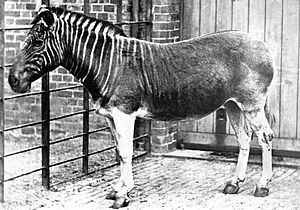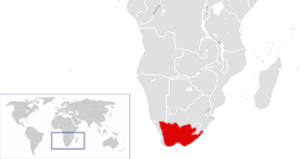Quagga facts for kids
Quick facts for kids Quagga |
|
|---|---|
 |
|
| Quagga mare at London Zoo, 1870, the only specimen photographed alive | |
| Conservation status | |
| Scientific classification |
|
| Kingdom: | Animalia |
| Phylum: | Chordata |
| Class: | Mammalia |
| Order: | Perissodactyla |
| Family: | Equidae |
| Genus: | Equus |
| Species: | |
| Subspecies: |
†E. q. quagga
|
| Trinomial name | |
| Equus quagga quagga (Boddaert, 1785)
|
|
 |
|
| Former range in red | |
| Synonyms | |
|
List
Hippotigris quagga Hamilton Smith, 1841
Hippotigris isabellinus Hamilton Smith, 1841 E. q. isabellinus Hamilton Smith, 1841 E. q. lorenzi Lydekker, 1902 E. q. greyi Lydekker, 1904 E. q. danielli Pocock, 1904 E. q. trouessarti Camerano, 1908 E. (Quagga) quagga quagga Shortridge, 1934 |
|
The Quagga (Equus quagga quagga), also Cape Quagga, is a recently extinct zebra.
It was one of the six subspecies of plains zebra. It was a yellowish-brown zebra with stripes only on its head, neck and forebody, and looks similar to an Okapi. The Quagga was native to dry grassy plains in the south of the African continent. It was found as far north as the Orange River. It is believed to have separated from other plains zebras between 120,000 and 290,000 years ago. The name Quagga comes from the noise that they made. (kwa-ka-ka) (qua-ga-ga).
The Quagga was hunted for food, for their skin and also because farmers did not want it to eat the grass they needed for their sheep and goats. The last wild Quaggas died during a drought in 1878. The last captive Quagga died in the Amsterdam Zoo on 12 August 1883. Her body is now in a museum. There are 23 Quagga specimens in museums, seven skeletons, and some skulls and other bones.
A foundation in Africa is trying to bring Quaggas back to life by taking zebras that have very light stripes and breeding them. They began in 1987 and the first Quagga foal was born in 2005.
Images for kids
-
1804 illustration by Samuel Daniell, which was the basis of the supposed subspecies E. q. danielli
-
Painting of a stallion in Louis XVI's menagerie at Versailles by Nicolas Maréchal, 1793
-
1777 illustration of a live quagga colt and a bagged adult Burchell's zebra male, by Robert Jacob Gordon
See also
 In Spanish: Cuaga para niños
In Spanish: Cuaga para niños





